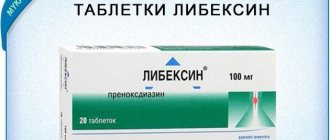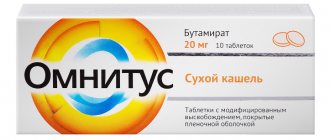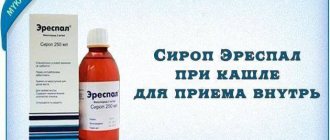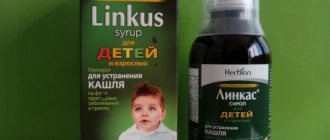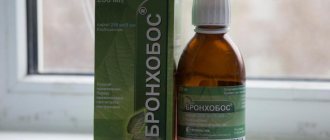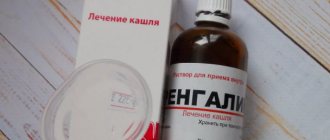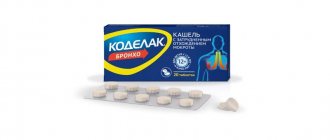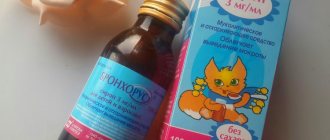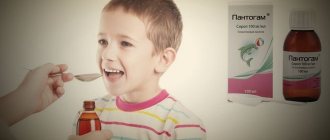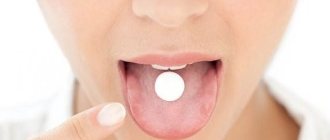Side effects
When using the drug, the following side effects may occur:
- malaise, weakness , dizziness ;
- angioedema , exanthema , urticaria , itching ;
- bullous dermatitis (including exudative erythema and Stevens-Johnson syndrome );
- anaphylactic reactions and allergic skin rashes;
- gastrointestinal bleeding , epigastric pain, diarrhea , vomiting , nausea .
special instructions
For alcoholism, epilepsy, liver diseases, injuries or diseases of the brain, it should be taken into account that Libexin Muco syrup contains 1.64% ethanol, which in terms of a measuring cup (1 dose = 15 ml) is 0.2 g.
Patients on a low-carbohydrate diet and patients with diabetes are advised to take into account that the sucrose content in 1 measuring cup of syrup is 6 g; in 1 measuring spoon of syrup for children – 3.5 g.
When following a salt-free or low-salt diet, the sodium content in 1 measuring cup of syrup should be taken into account as 0.097 g.
It is not recommended to use Libexin Muco in patients with fructose intolerance, sucrase/isomaltase deficiency, or glucose-galactose malabsorption syndrome, since the syrup contains sucrose.
Impact on the ability to drive vehicles and complex mechanisms
During drug therapy, when driving vehicles or engaging in other potentially hazardous activities, caution must be exercised due to the possible development of side effects such as dizziness and weakness.
Patients taking Libexin Muco syrup must remember that the presence of ethanol in its composition can reduce concentration and affect the speed of psychomotor reactions.
Libexin Muko syrup, instructions for use (Method and dosage)
Adults need to take one measuring cup (15 milliliters) three times a day, preferably before meals.
Instructions for use Libexin Muco for children
Children over five years old - one measuring spoon three times a day, and children from two to five years old - one measuring spoon twice a day.
One scoop of syrup (five milliliters) contains 100 milligrams of carbocisteine.
Without consulting a doctor, the duration of treatment should not exceed 8 days.
Release form and composition
Dosage forms of Libexin Muco:
- syrup: thick, viscous, syrupy liquid from light brown to brownish-yellow color (125, 200 or 300 ml in clear glass bottles, sealed with an aluminum cap equipped with tamper evident; 1 bottle in a cardboard box complete with a measuring cup) ;
- syrup for children: thick, viscous, syrupy red liquid (125 or 200 ml in clear glass bottles, sealed with an aluminum cap equipped with tamper evident; 1 bottle in a cardboard box complete with a measuring spoon).
100 ml of syrup contains:
- active substance: carbocysteine – 5000 mg;
- auxiliary components: sucrose, preservative methyl parahydroxybenzoate, caramel powder coloring (E 150), aromatic elixir (ethanol - 55.3%; rum - 42.7%; rum flavoring additive - 2.0%), cinnamon oil, sodium hydroxide , purified water.
A 15 ml measuring cup of syrup contains: carbocysteine – 750 mg; sucrose – 6000 mg; ethanol – 200 mg; sodium – 97 mg. Ethanol content (v/v) is 1.64%.
100 ml of syrup for children contains:
- active substance: carbocysteine – 2000 mg;
- auxiliary components: sucrose, preservative methyl parahydroxybenzoate, crimson dye Ponceau 4R [cochineal red A (E 124)], raspberry and cherry flavors, sodium hydroxide, purified water.
A 5 ml measuring spoon of syrup contains: carbocysteine – 100 mg; sucrose – 3500 mg; sodium – 13 mg.
Interaction
Syrup for adults contains alcohol, so it must be taken with caution with Procarbazine, Ketoconazole, nitro-5-imidazoles, Griseofulvin, Tolbutamide, Glipizide, Glibenclamide, Chlorpropamide, chloramphenicol, Latamoxef, Cefaperazone, Cefamandole, Disulfiram , since simultaneous use may cause tachycardia , vomiting, redness and fever .
The effectiveness of carbocisteine is weakened when taken simultaneously with atropine-like and antitussive drugs .
Contraindications
Absolute:
- exacerbation of peptic ulcer of the stomach and duodenum;
- exacerbation of chronic glomerulonephritis, cystitis;
- pregnancy period;
- children's age: up to 2 years (syrup for children); up to 15 years (syrup);
- individual hypersensitivity to carbocisteine and other components of the drug.
Relative contraindications (Libexin Muco is taken with caution):
- history of gastric and duodenal ulcers;
- lactation period (breastfeeding).
Analogs
Level 4 ATX code matches:
Mukolik
Abrol
Ambrosan
Bronchorus
ACC 100
ACC 200
ACC Long
ACC
Mukolwan
Lazolvan
Bromhexine 8
Bromhexine 8 Berlin-Chemie
Bromhexine
Bronchobos
Carbocisteine
Erdomed
Pulmozyme
Pectolvan C
Halixol
Ambrobene
Analogs of this syrup are:
- Mucosol;
- Bronchobos;
- Mukodin;
- Fluifort.
Benefits of syrup
The drug Libexin is popular in the treatment of respiratory diseases, which can be confirmed by numerous positive reviews from patients. Doctors prescribe it because of its many benefits:
- The syrup effectively relieves painful coughs.
- Used for any stage of respiratory tract disease.
- Has a local anesthetic effect.
- The antitussive effect lasts up to four hours.
- Without depressing breathing, it reduces the activity of the cough center. When taking medications that contain codeine, the respiratory centers are depressed.
- Not addictive.
Libexin Muco price, where to buy
The price of Libexin Muco in Russia is on average 370 rubles.
In Ukraine, the drug can be purchased for an average of 150 hryvnia.
- Online pharmacies in RussiaRussia
ZdravCity
- Libexin Muco syrup 5% 125mlUniter Liquid Manufacturing/A.
Nattermann & See GmbH RUR 543 order - Libexin Muco syrup for children. 2% 125mlUniter Liquid Manufacturing/A.Nattermann & See
500 rub. order
Pharmacological properties
Pharmacodynamics
The active component of Libexin Muco is carbocisteine, a mucolytic that affects the gel phase of endobronchial secretion by breaking the disulfide bridges of glycoproteins, which leads to a decrease in viscosity and increased elasticity of the secretion.
Pharmacological activity of carbocisteine:
- activation of sialic transferase (enzyme of goblet cells of the bronchial mucosa);
- normalization of the quantitative ratio of neutral and acidic sialomucins;
- regeneration of the mucous membrane by normalizing its structure;
- stimulation of the activity of the ciliated epithelium;
- restoration of the secretion of an immunologically active specific protective factor - immunoglobulin A (IgA);
- improvement of mucociliary clearance.
Pharmacokinetics
After oral administration, carbocisteine is rapidly absorbed, reaching maximum serum concentrations 2 hours after administration. It has low bioavailability (<10% of the dose taken), possibly due to rapid passage through the liver. T1/2 (half-life) is about 2 hours. Carbocysteine is excreted along with metabolites mainly by the kidneys.
Libexin
Libexin (prenoxdiazine hydrochloride) is an antitussive drug with a peripheral mechanism of action. It has a number of properties that make it popular both among doctors and among a wide range of patients. Libexin reduces the hyperreactivity of the cough center without suppressing breathing (which is the “sin” of the same codeine-containing drugs), its effect lasts for 4 hours, during which the drug relieves cough and exhibits a local analgesic effect. The use of Libexin will be beneficial at any stage of the respiratory tract disease. The mechanism of action of the drug develops in three directions: reducing the intensity of coughing attacks (antitussive component), increasing the lumen of the bronchi and facilitating the evacuation of sputum (expectorant component), eliminating pain when swallowing (analgesic component). The use of the drug allows you to reduce the frequency and intensity of attacks of dry cough, improve the quality of sleep by eliminating nighttime coughing attacks. The severity of the antitussive effect of Libexin is comparable to that of codeine-containing drugs. For chronic inflammation of the bronchial tree, the drug has an anti-inflammatory effect. The drug does not affect the functions of the central nervous system, with the exception of a mild anxiolytic (anti-anxiety) effect. The active component of the drug, prenoxdiazine hydrochloride, is quickly and completely absorbed from the gastrointestinal tract. Peak concentration in the blood is recorded half an hour after administration.
A concentration sufficient to provide a therapeutic effect is maintained for 7-8 hours. The half-life is 2.5 hours. Elimination from the body occurs through feces and, to a lesser extent, urine. Libexin is indicated for non-productive (dry) cough of any etiology. Contraindications to taking the drug are individual intolerance to prenoxdiazine, diseases accompanied by activation of the secretory function of the bronchi. During pregnancy, lactation and childhood, Libexin is used with extreme caution. A single dose for adults is 1 tablet (if necessary, can be increased to 2-3 tablets). The frequency of administration is 3-4 times a day. For children, the dose is determined depending on body weight. Side effects are rare and may include allergic reactions, hyposalivation, and dyspeptic symptoms. If the recommended doses are exceeded, a slight hypnotic effect and increased fatigue may be observed, which disappear after discontinuation of the drug. Libexin is not recommended to be combined with secretolytics and expectorants, because the former may impair the evacuation of liquefied sputum. Libexin contains lactose as an auxiliary component, which can cause gastrointestinal disorders. While taking the drug in submaximal and maximum doses, it is recommended to refrain from activities that require increased attention and concentration.
Overdose
If you follow the dose prescribed by the doctor, there is no risk of overdose . But some patients believe that the syrup is a weak remedy and the more you take, the faster the effect will come. Such an erroneous opinion can lead to the accumulation of medicine in the body, which may result in skin itching, lethargy, dizziness, nausea, and gastralgia. And a fragile child’s body may respond to an overdose with either slight weakness or even Quincke’s edema. In any case, you should stop taking the syrup and go to see a doctor, who will prescribe symptomatic treatment.
What does it help with?
As mentioned earlier, this drug is used as an expectorant for dry, prolonged cough. The product moisturizes the respiratory tract, promoting the removal of viscous and difficult to remove mucus. It helps improve mucociliary clearance. The doctor prescribes Libexin syrup for children for the following diseases:
- bronchial asthma;
- tracheitis;
- bronchitis;
- laryngitis;
- pneumonia and pneumoconiosis;
- tuberculosis (early stages);
- laryngotracheitis;
- nasopharyngitis;
- nasopharyngitis;
- pathology of the bronchopulmonary system;
- bronchiectasis;
- rhinitis, otitis, sinusitis;
- tracheobronchitis;
- the drug is used in preparation for bronchography or bronchoscopy.
Price
How much does Libexin for cough cost? In many pharmacies, the cost of this product can be high, ranging from 480-520 rubles. However, you can buy it in an online store or purchase a cheaper option - an analogue of Libexin. You can order it inexpensively on the Internet in the following way: choose the price you need from the catalog, read customer reviews on the website and order delivery.
| A drug | Price, ruble |
| Libexin (syrup) | 480 |
| Libexin (tablets) | 530 |
| Prenoxdiazine | 440 |
| Glauvent | 350 |
Medicinal composition
The abstract names carbocysteine as the active ingredient. Additional substances in the composition of the drug help the main component to be well absorbed, maintain the duration of action, and give a pleasant color and aroma.
Contains sucrose. If the patient is intolerant to this substance or has diabetes mellitus, the medicine should be replaced with a similar one.
The active substance in children's syrup is 2%. A syrup with the same name is produced, which has 5% of the active ingredient, with this ratio it is designed for the adult age category. This syrup should not be given to children, as it contains ethyl alcohol.
